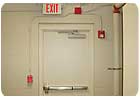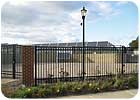
Built in 1917 in Kansas City, Mo., the Brookside Hotel and Apartments have been renovated into Crestwood Condominiums. Two floors and new elevators and stairwells have been added.
“If these walls could talk…” This old expression is particularly appropriate for the historic Brookside Hotel and Apartments in Kansas City, Mo., that have been renovated into the Crestwood Condominiums.
The Brookside, which is the grande dame of the city’s historic Country Club District, has a long, storied and varied history. Built in 1917 and designed by John McKenknie, one of Kansas City’s most prolific architects, the building’s function over the years has varied widely.
It has served as temporary housing for military personnel in World War II, as a dormitory for the St. Paul School of Theology, and as a home-away-from-home for flight attendants, among other purposes. Most recently, however, the five-story treasure sat vacant and in a sad state of disrepair.
But this past year, developers Ralph Myers Jr. and Frederick Truog, along with an impressive team of architects and vendors, gave the building a new life as Crestwood Condominiums. Although the interior has been completely remodeled and two floors added along with new elevators and stairwells, the structure’s character remains intact.
Ironically, because of one of the building’s most technologically advanced additions, the walls of the new Crestwood Condominiums can, in a sense, “talk.” The structure now can communicate any smoke or fire danger to building management, residents and the fire department through a state-of-the-art life safety system.
Service Electric, Blue Springs, Mo., installed the fire system in the Crestwood Condominiums. The company provides service for engineering and design-build projects, new construction, renovations, and tenant finish. It already had been entrusted with all the building’s high- and low-voltage electrical work.
The low-voltage duties, which included telephone entry (access control) and the fire alarm system, fell under the aegis of Shawn Grey, Service Electric’s project manager. His company’s ability to handle low-voltage jobs was a major plus.
“Typically, it’s one of the low-voltage systems that fail on a project,” Grey maintained. “Low-voltage work is very specialized and has to be handled differently than high-voltage.”

Service Electric, Blue Springs, Mo., served as the installer of the Farenhyt IFP-1000 addressable control panel from Silent Knight, Maple Grove, Minn.
The Brookside, which is the grande dame of the city’s historic Country Club District, has a long, storied and varied history. Built in 1917 and designed by John McKenknie, one of Kansas City’s most prolific architects, the building’s function over the years has varied widely.
It has served as temporary housing for military personnel in World War II, as a dormitory for the St. Paul School of Theology, and as a home-away-from-home for flight attendants, among other purposes. Most recently, however, the five-story treasure sat vacant and in a sad state of disrepair.
But this past year, developers Ralph Myers Jr. and Frederick Truog, along with an impressive team of architects and vendors, gave the building a new life as Crestwood Condominiums. Although the interior has been completely remodeled and two floors added along with new elevators and stairwells, the structure’s character remains intact.
Ironically, because of one of the building’s most technologically advanced additions, the walls of the new Crestwood Condominiums can, in a sense, “talk.” The structure now can communicate any smoke or fire danger to building management, residents and the fire department through a state-of-the-art life safety system.
Service Electric, Blue Springs, Mo., installed the fire system in the Crestwood Condominiums. The company provides service for engineering and design-build projects, new construction, renovations, and tenant finish. It already had been entrusted with all the building’s high- and low-voltage electrical work.
The low-voltage duties, which included telephone entry (access control) and the fire alarm system, fell under the aegis of Shawn Grey, Service Electric’s project manager. His company’s ability to handle low-voltage jobs was a major plus.
“Typically, it’s one of the low-voltage systems that fail on a project,” Grey maintained. “Low-voltage work is very specialized and has to be handled differently than high-voltage.”

The fire system uses 139 addressable points, with the option of expanding to 1,016 points, helping the user determine exactly which device has been activated or requires attention.
The Silent Knight RPS-1000 power supply offers a “Flexput” circuit feature. With Flexputs, an installer has the option of establishing each of the panel’s six circuits as either an input or an output, which provides more flexibility.
All parties involved in the project – Grey, building manager Donna Shippy and the local fire department – approve of the system.
“During an alarm situation, the panel tells us exactly where in the building the problem is taking place,” Shippy noted. “The system triggers doors that automatically drop down in front of the elevators, blocking their use. Residents are directed to the closest stairway and then to the nearest exit or safe area. The whole building is protected – I feel like it’s my guardian angel.”
Sidebar: On the Job
From Silent Knight:- Farenhyt IFP-1000 addressable control panel
- One RA-1000 remote annunciator
- RPS-1000 intelligent power supplies

Sidebar: projects in the news
DVR Is Sole Protection for Solar ArrayMAC Systems, Canton, Mass., was chosen by the City of Brockton, Mass., to provide a security system to protect a former manufactured-gas plant site (brownfield) that was redeveloped into a brightfield – a solar energy generating station that converts sunlight to clean electricity. Brockton’s Brightfield consists of 1,395 SCHOTT solar photovoltaic modules covering a 3.7-acre site. Providing 526,612 kilowatt hours of electricity annually, it is the largest solar array in New England and the largest brightfield nationwide. Instead of deploying sensor equipment throughout the large ground-mounted, unmanned site, the motion detection capabilities of the DVR5100 from Pelco, Clovis, Calif., were selected. Capable of detecting movement in the fields of view of any of the perimeter cameras, the 5100 can trigger a relay that causes the alarm panel to send a signal to the central monitoring station.





